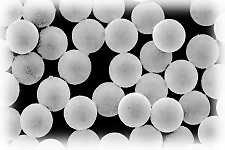Magnetic Silica particles - a fast method for DNA/RNA purification and Protein separation
Separation techniques are goinig to be more and more important in biotechnology, to get on cost efective, simple , reproducable ways and by using automatisation systems. The large surface area of 50m2/g provides a high capacity to bind cells, bacteria, DNA/RNA , proteines or antibodies.These paramagnetic uniform non porous silica particles are with 80% magnetit content allow simple magnet separation. The are supolied in double destilled H2O, but can be offered in powder form on request.
main applications of the chemical modifications:
Silanol:DNA & RNA techniques, purification of genomic DNA, plasmid DNA, viral DNA or PCR products.
DNA/RNA bind to the silica beads under high salt conditions as 4 mol NaL or 5 mol GuSNC.
Silanol-ROB: especially developed for use of DNA/RNA separation in robotic systems.
Carboxyl: binding of bioactive substances by the Carbodiimide methode
Amino:binding of bioactive substances by the Carbodiimide methode
Cyanuric replaces Chloromethyl due to better binding characteristics
Streptavidin: biotin labeled molecules
Biotin:avidin/streptavidin labeled molecules
available on request: magnetic silica beads with Protein A andG, Oligo(dt), calf tymus DNA, Albumin and GaM (Fc).


